Ukrainian Independence after 1991
Chapter 5: Activism and National Self-Determination
Andrew Harding and Bridget O'Keefe
After centuries of attempts towards independence and nationhood, Ukrainians finally achieved their long-harbored dream in December of 1991 when the referendum was signed that would dissolve the Soviet Union and recognize Ukraine as an independent nation once and for all. This was a momentous occasion in Ukraine’s history. That said, despite being free from an oppressive Soviet regime, Ukraine experienced many growing pains as it transitioned from centuries of colonization to an emerging democracy. This transition did not come without its complications, including post-Soviet thugs, a corrupt police force, and high inflation with many Ukrainians struggling to remain afloat. The years following the collapse of the Soviet Union were troubled times associated with widespread lawlessness.
In addition, some areas were more impacted by Russia’s influence resulting from years of Soviet rule and Russian colonization. There was a political divide between east and west within Ukraine that would later influence the actions of Ukrainians and play out in the political sphere, as the citizens sought to shape this emerging era in Ukraine’s history with the freedom to do so. Areas in eastern Ukraine were especially influenced by Russian nationalism. In the east, Ukrainians were more Russified, resulting in Ukrainian heritage and identity essentially being washed away by Russo-Soviet indoctrination. Many Ukrainians in the east held political opinions aligned with those of the Russian government, and expressed hopes of maintaining Russian culture, language, and ties as evidenced by their voting habits. This political dichotomy was realized following the collapse of the Soviet Union, and it would influence the coming years as Ukrainians manifested their beliefs about what a Ukrainian nation should look like (Anieri 2012).
It took time for a stable government unencumbered by corruption to emerge, but after a few years of tragedy and disorder, most people had had enough. They sought change and held onto the Western dream of establishing a true democracy. Two major events, one in 2004 and a second in 2013-2014, sparked major uprisings, especially among young Ukrainians who had never endured the previous Soviet era, and who wanted to initiate pivotal changes in Ukraine as it sought to be a fully democratic nation. In the capital city, Kyiv, on the expansive plaza known as the Maidan (Independence Square), this place would become the cornerstone of both revolutions, aggregating large masses of people together in the dead of winter to protest against the ongoing delinquency within government organizations and Russian manipulation (Shore 2022).
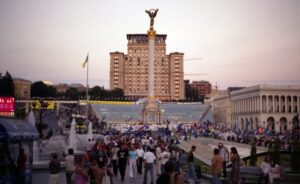
The 2004 revolution, known as the Orange Revolution, was organized in response to a fraudulent election in which a pro-Russian, post-Soviet gangster, Victor Yanukovych, won what was largely deemed a falsified election despite being highly unpopular among many Ukrainians. Later in 2013-2014, when Victor Yanukovych justly became president, the second revolution known as Euromaidan, also referred to as the Revolution of Dignity, took place following President Yanukovych’s last-minute decision to not sign a European Union agreement, which would have put Ukraine on a path towards joining the EU and represented a step closer to integration with the West. This second revolution brought out many more Ukrainians than the Orange Revolution did. People felt that their dignity as human beings was being stripped away, and they wanted to break Russia’s grasp on Ukrainian society, culture, and politics. Not long after the Revolution of Dignity ended in early 2014, Crimea was annexed, and the separatist uprising in the Donbas region of Ukraine began, which was the preamble to the current conflict as we know it (Shore 2022).
Throughout any revolution, war, or conflict, art has been an important medium and transformative intervention for those involved to release the negative emotions that arise from such life-altering events. Art preserves the memories and veracity of history, serving as an artifact for future generations. This is especially true for Ukraine, where for centuries Russia has absorbed Ukrainian culture and claimed it as its own. Russia has been rewriting Ukrainian history from the very beginning (Yurchuk 2021). Therefore, art has made an impact on these major movements in Ukraine, including the Orange Revolution and Revolution of Dignity, and it continues to do so with this current crisis by enlightening the world about the atrocities perpetrated by Russian troops and invalidating Russian propaganda.
In this chapter, we introduce the major events following 1991 that shaped Ukrainian politics and initiated activist movements throughout the country, and highlight how these events have led to the current response from Ukrainians today. One aspect that has made Ukraine so successful throughout this full-scale invasion is the collective response by Ukrainians, which in some ways can be attributed to the activism in 2004 and 2013-2014 that initially united the country towards a common set of goals.
The Orange Revolution
Ukraine emerged from years of Soviet dominion, and immediately experienced a period of disorder, crime, and corruption. One likely catalyst to the Orange Revolution before the protests began on the Maidan was when Georgiy Gongadze, a Georgian-Ukrainian journalist, was kidnapped and later killed after exposing the corruption within the government. It was later discovered from voice recordings that President Leonid Kuchma was involved in the kidnapping and death of Gongadze that followed. This catalyst set the stage for the events that followed and was highly reflective of the political nature of Ukraine at the time. This event clearly exemplified the need for radical change during this period (York 2007).
The 2004 elections followed the race of two Viktors: Viktor Yanukovych and Viktor Yushchenko. These two political candidates adhered to conflicting political perspectives. Yanukovych was close to the Kremlin and was endorsed by Kuchma, the then-president accused of murdering the journalist described above. He was also pointedly against plans to westernize Ukraine and was infamously known in Ukraine for his past as a criminal, having gone to prison twice. Then there was Yushchenko, who was more Western-leaning and hoped to put Ukraine on a path toward European Union integration. Yushchenko was widely supported by most Ukrainians and especially young adults. With Yushchenko, Ukrainians believed that they could achieve the democracy that they had always dreamed of with closer ties to the West and the extermination of extortion (York 2007).
Unfortunately for Yushchenko, Yanukovych and his political team made campaigning nearly impossible for him. For one, Yushchenko was not allowed to appear on TV or radio, so his only form of communication and campaigning was through concerts. He organized bands that would come play their music, which brought people in, and Yushchenko would appear later on to engage the crowd. Another hurdle to Yushchenko’s campaign was the dioxin poisoning that sent him to the hospital for days. It was suggested that Yushchenko ingested the toxin, but is still unclear as to who might have poisoned him; it was likely in connection to Yanukovych. The poison left Yushchenko’s face completely disfigured. Not long after Yushchenko was poisoned — he was still in the hospital — Yanukovych staged an attempted “assassination” and claimed that an associate of Yushchenko targeted him in an attempt to spoil Yushchenko’s reputation. After further investigation into the situation, it was discovered that it was only an egg thrown at Yanukovych (York 2007).
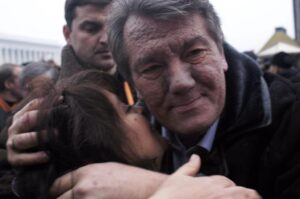
When election day arrived, exit-poll results showed that Yushchenko was in the lead, but what was being projected by the Central Election Commission of Ukraine was that Yanukovych was the winner. There were many attempts by the Central Election Commission and followers close to Yanukovych to disrupt the election results. Acid was spilled on some ballots, for example, making them illegible. On November 22, 2004, the Central Election Commission announced that Yanukovych had won; the people of Ukraine were in complete shock and filled with anger. It was on that night that large masses of people organized on the streets of the Maidan to protest the falsification of the results. By 8 AM on November 22, there were around 500 people on the Square, and a few hours later, at 12 PM, there were an estimated 80,000 protestors. The numbers continued to rise as the protests continued, and Yushchenko called for more Ukrainians to join in the demonstration. Ukrainians planned to stay on the Maidan until the election results were renounced (York 2007).
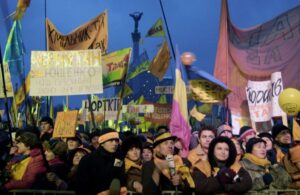
This revolution was completely financed by the people. They installed a tent city within the square with food and other necessities provided for those who stayed. The Maidan became a city within itself. Everyone wore orange, representing Yushchenko’s campaign colors, and stood in the frigid temperatures of late November for days on end. People would huddle together standing near a fire to warm up and withstand the freezing temperatures, especially during the night. Bands would play music for the crowds of people, and Yushchenko often made an appearance to speak to the protestors (York 2007).
Social identities influenced the types of people who were seen on the Maidan during the Orange Revolution. As mentioned before, young adults were at the forefront of both revolutions; they were most passionate about the issues preventing Ukrainian society from progressing and active in their approach to making change. A study from the European Social Survey found that Ukrainian young adults held values most aligned with European youth at the time, as opposed to the values of middle-aged Ukrainians, who were less liberal and Westernized, likely a result of years of Soviet rule. Ukrainian youth saw the Orange Revolution as a way to demand a fair election that would play in their favor, and elect a president who shared many of their Western ambitions for Ukraine (Reznik 2016).
In addition to being youths and young adults, most protestors were men. In this early post-Soviet atmosphere, women were still trying to find their way. Although they had more freedom of expression, women were competing to be heard and recognized in their society, since women at the time were largely acknowledged as caretakers and mothers (Reznik 2016). This traditional Ukrainian stereotype was heavily reinforced in the early stages of Ukraine’s independence movement. Berehynia, a Ukrainian goddess whose image is depicted and sculpted on the Maidan, has been glorified as a caretaker and protector of her children and the Ukrainian nation from colonialist influences. Berehynia was the embodiment of Ukrainian womanhood and idealized the position of women in society as caretakers and protectors of Ukraine. At the time of the Orange Revolution, Ukraine was still dominated by patriarchal structures, so many women remained in their houses during these protests (Bisikalo 2017).
Other determinants of participation included linguistic identity, regional division, and social status. The majority of protestors were from largely populated areas in the west and center of Ukraine and of higher social status, people who had the means to leave work and stay on the Maidan for days on end. Also, most were largely Ukrainian native speakers. These identities correlate with many of the identities of Western-leaning Ukrainians described above (Reznik 2016).
While the protests continued, the Central Election Commission of Ukraine gathered to certify the results of the fraudulent election and claim Yanukovych as president. The revolutionaries of Ukraine refused to accept this decision. They continued to protest on the streets of the Maidan until the election results were revoked. Protestors also gathered in front of government buildings, including the Presidential Administration in Kyiv, as police barricaded the buildings. Although the police force was dispatched, no brutality was enforced by the superiors such as President Kuchma. Eventually, on December 26, 2004, after nearly a month of protests, the Supreme Court determined with the help of whistleblowers that the election was fraudulent, exposing Yanukovych and his team of all the tactics used to turn the election in their favor. Another election was held with safeguards in place to ensure the election was fair, and finally, the Ukrainian people elected Viktor Yushchenko (York 2007).
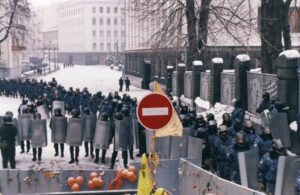
The Orange Revolution was just the start of activism within Ukraine as an independent nation, and it ignited a flame within Ukrainians to speak out against corruption. Once again, during the Revolution of Dignity ten years later, Ukrainians gathered in the streets of the Maidan during the frigid winter months to protest against Russian oppression. This time Yanukovych was president, and Ukrainians saw once again his corrupt nature and ties to the Kremlin.
The Revolution of Dignity
As one observer of the Revolution of Dignity noted, the first feet to hit Kyiv’s Independence Square on November 21, 2013, “belonged to students” (Channell-Justice, 2014). In her article on the role of student activism during the protests, Emily Channell-Justice pays homage to the group of people who both started this revolution in protest, and then used the violence they faced to stand up for their country and create longstanding change within Ukraine. The feet who stepped foot in the Independence Square were a response to President Viktor Yanukovych’s sudden refusal to sign a long-anticipated “association agreement” with the European Union that would have put Ukraine on a path toward Europe. Although there were faults to this agreement (including that Ukraine would have had to undertake costly reforms to get in line with EU regulations, and it did not make any specific promises about EU membership), it was seen as a major symbolic victory for Ukraine.. As Marci Shore notes, this offer was a gesture showing that “the doors of Europe would be open to Ukraine” (Channell-Justice 2014).
This issue resonated particularly with ambitious young people and students, since joining the European Union would lead to many opportunities not otherwise available. Some of these include studying abroad, learning foreign languages, traveling around Europe, and taking internships and jobs abroad. Many young people felt that this decision determined their future. Others hoped that the agreement would embrace European ideals, and therefore strengthen Ukraine’s democratic institutions, specifically trying to reign in the widespread corruption within the current regime. This corruption was epitomized by President Yanukovych, known for his extreme wealth and his earlier attempt at the presidency in 2004, when he was suspected of poisoning his opponent and rigging the election. Although the people got their wish and the Russian-backed Yanukovych did not win the original election in 2004, Yanukovych winning back the presidency in the subsequent election in 2010 represented what little institutional change had occurred in Ukraine despite the Orange Revolution.
Now, many of the same people who had grown up during the Orange Revolution felt it was their turn to try and create change. On November 21st, a small group of protestors, mostly young students, once again met in Kyiv’s Independence Square, the same location where they had protested a fraudulent election less than a decade before. They protested peacefully in the cold, where they held hands, danced, and played music while broadcasting their slogan, “Ukraine is Europe.” It was a simple statement, but one that referred to a conflict that had existed for hundreds of years before. Was Ukraine part of the West, or of Russia? Being considered part of the West meant joining the European Union, embracing Democratic ideals, and rejecting the influence and threat that Russia has posed to Ukraine for centuries. The students protested peacefully for nine days, when on November 30th at around four in the morning, Yanukovych sent out riot police, known as Berkut, to disperse the protestors by brutally beating them up. Although no one died, many people were seriously injured. This was all the more horrific since most of the people hurt were the young students that were symbolically seen as the future of Ukraine. This was the first time since 1991 where the regime used mass violence against its own people. Instead of deterring the protestors, they actually inspired many more people to join the cause.
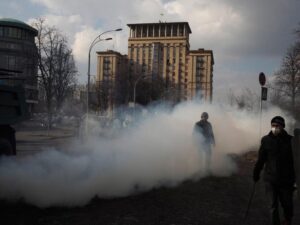
At that time, the movement then shifted from a protest against Yanukovich’s refusal to sign the association agreement with the EU, to a protest against the current government, state-sanctioned violence, and corruption. On December 1st, a mass march was held in Kyiv. In order to combat the increase in protests in Kyiv, the government passed the January 16th laws (also known as the Bondarenko-Oliynyk laws), which made it illegal to wear helmets or uniforms at protests, participate in mass disruptions, and permitted the government to cut off internet access, levy higher fines and increased prison terms for protesters, and granted impunity to police officers who used force against protestors. In part due to these strict regulations, increasingly bloody clashes took place between the protesters and police with their government-hired thugs.
The violence eventually reached a peak in mid-February 2014, when seventy-seven people died in three days, including nine police officers and sixty-eight protesters. Overall, more than a hundred people died in these clashes, and the killings resulted in increased pressure on the government to resolve the protests. Due to threats of international sanctions, the Ukrainian parliament passed a resolution prohibiting the use of force by the government. With both the people and parliament against him, Yanukovych fled the country. More importantly, his absence allowed a new provisional government to be elected. Many of the new leaders were activists, journalists, and leaders from the revolution who were entering politics for the first time. This development was monumental, especially because politics and politicians had a very bad reputation in Ukraine: they were seen as corrupt and immoral, and politics was looked at as a very dirty business. Some key examples were President Leonid Kuchma’s media censorship that culminated in the killing of a journalist, and Yanukovych’s purported theft of more than $7.5 billion U.S. dollars for himself and his partners. Both of these examples were quite brazen, and each essentially got away with their crimes. These new politicians from the Maidan helped regain some public trust in the government, and led to many important changes in legislation in order to accommodate some of the issues brought up during the protests.
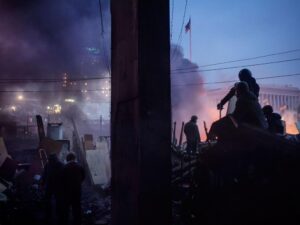
One of the biggest differences between the Orange Revolution and the Revolution of Dignity was that, although Ukraine’s national identity had shifted slightly after the Orange Revolution, in 2014 Ukraine fully embraced Western democratic principles. Ukrainian citizens became more united, defining themselves in their struggle against Russian aggression and attempts to destroy Ukrainian statehood. There were also more long-term changes that resulted from the 2014 protests compared with the Orange Revolution. With the provisional government came new politicians, many of whom had played major roles in orchestrating the Euromaidan. This activism also set a new standard for the government not to control the people, and demonstrated that the people would not tolerate a government that did not allow the right to protest.
Another distinct feature of the Revolution of Dignity was that more women were involved, although their participation has largely been misrepresented. Initially, when the protests were still peaceful, women made up 42.8% of the protestors on the Maidan. They began to establish themselves in society and take on more traditionally masculine roles, such as building barricades and fighting. In addition, women would donate food, clothes, medication, and other necessities that were needed on the Maidan and provide medical assistance to those who were injured. Once the protests became violent, however, women were forced from the scene, as they were still seen in Ukrainian society as “delicate” and “fragile” (Bisikalo 2017).
This rise in women’s participation likely resulted from the emergence of foreign non-governmental organizations that sought to mitigate gender inequality in Ukraine, as well as women’s rights activist groups. In addition, President Yanukovych sparked ire among women due to his often inappropriate comments and dismissive attitude towards women (for instance, he had told his political opponent, Yulia Tymoshenko, that she should “fulfill her feminine whims in the kitchen”). For many, his refusal to sign the EU association agreement was the breaking point. The emergence of NGOs and feminist activist groups flourished after the events of 2004 during the Orange Revolution (Bisikalo 2017). In 2008, for example, the controversial and radical Ukrainian feminist group, Femen, known for their topless political protests, was founded by Anna Hutsol, Oksana Shachko, Inna Shevchenko, and Oleksandra Shevchenko (Nikolayenko 2018). One year later in 2009, several feminist marches were organized in cities around Ukraine. More than 200 people of different sexes, ages, nationalities, and other identities came to the streets of Maidan to voice their opinions and advocate for equal rights. This was the first time in Ukraine’s history that the word feminism was being used in the general public (Kis 2012).
During the second revolution, women felt that they had more of a voice and were assertive. Many chose to participate in the Revolution of Dignity not due to gender inequality (only 8 percent cited that as their reason for participation), but due to their dissatisfaction with the government. They hoped for a better future more aligned with the European standard of living, as did other Ukrainians involved in the protests. Despite some backlash from society, especially as the protests turned violent, women made their mark on the Maidan during the 2013-14 protests and demonstrated their fortitude and courage in times of adversity (Nikolayenko 2018).
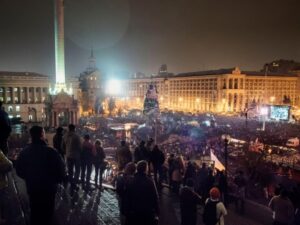
Current Activism
The greater impact of these revolutions was the culture of activism they created in Ukraine and beyond. During the ongoing war in Ukraine, this activism has played an essential role in broadcasting Ukraine’s conflict to the rest of the world. Artists have both documented the war, while also using more creative methods to demonstrate the feelings the war has unleashed in Ukraine. In this way, the art has become a catalyst through which outsiders can understand and empathize with Ukrainians.
Another important reason Ukrainians have created art during this war is so that the history of Ukraine can be remembered regardless of the outcome. Many in Ukraine believe that if Russia should win the war, they would completely repress Ukrainian culture and history, as they have tried to do in the past. By creating art, they are reminding the world that Ukraine has its own past and identity that is separate from Russia’s. The myth pushed heavily by Russia that they are “the same country,” with age-old references to Ukraine as “Little Russia,” is increasingly seen as a misconception at best, and at worst a lie advanced over centuries of settler colonialism. Long after the war ends, the art produced by today’s Ukrainian artists will live on, preserving their culture and the struggle of their resistance.

